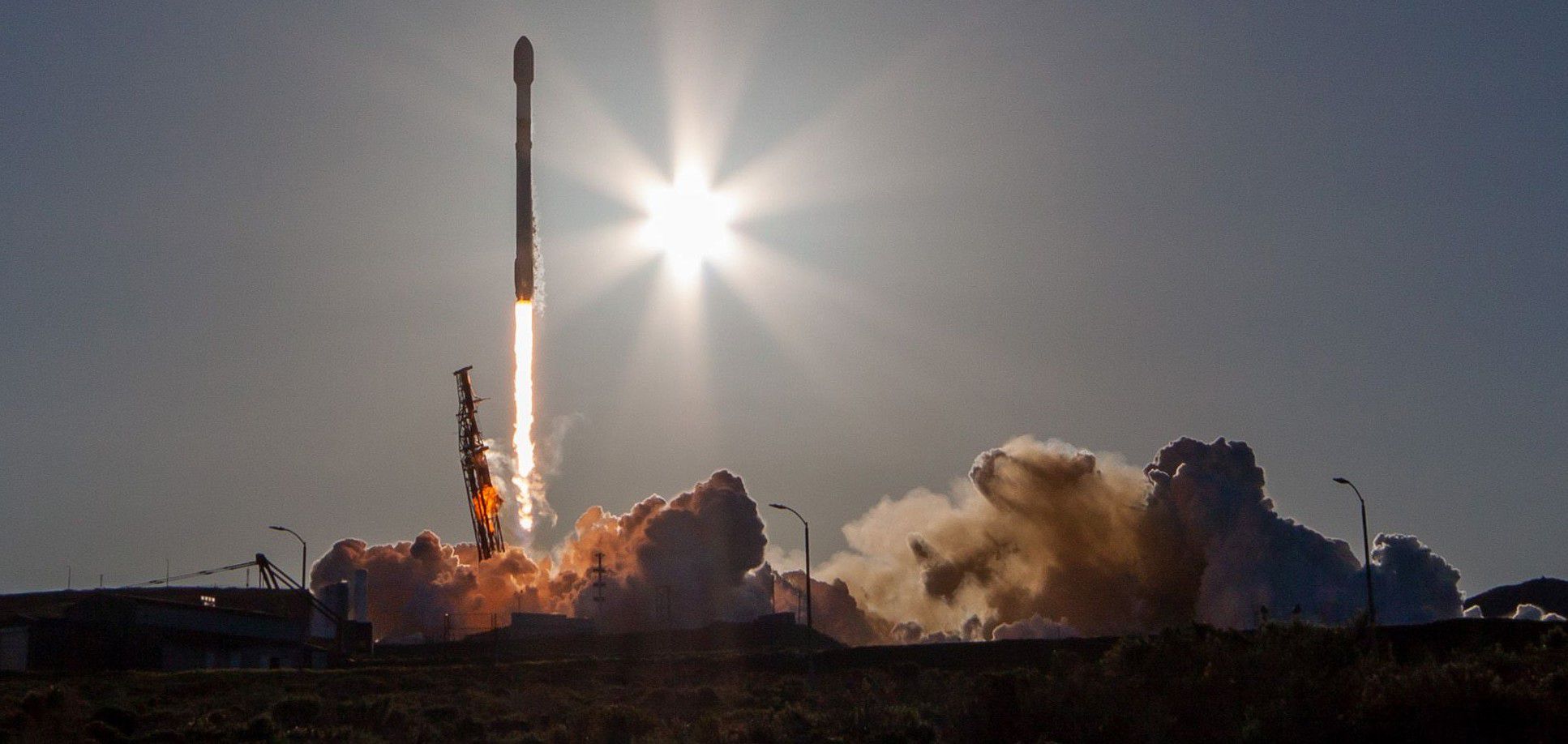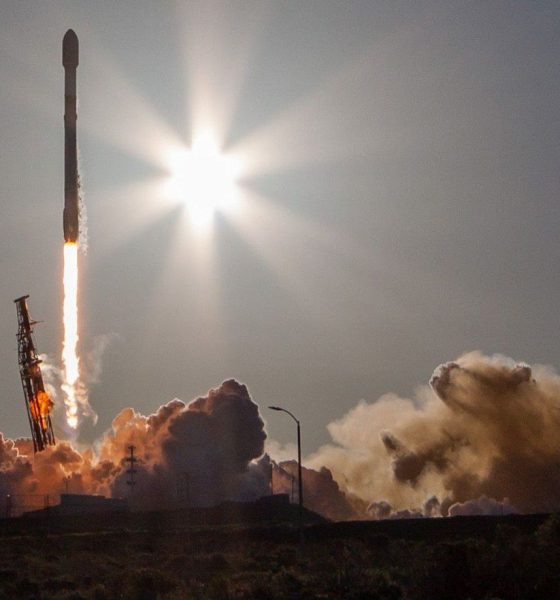SpaceX has launched its Falcon 9 rocket for the 200th time.
Measuring 70 meters (230 ft) tall and 3.7 meters (12 ft) wide, the 200th Falcon 9 rocket lifted off from SpaceX’s Vandenberg Space Force Base SLC-4E pad on January 31st, 2023. Beyond the statistical milestone, the Starlink 2-6 mission was a mostly ordinary launch of SpaceX’s own internet satellites.
However, SpaceX removed a pair of 310-kilogram (~680 lb) Starlink V1.5 satellites to make room for an ION orbital transfer vehicle (space tug) built by Italian space logistics company D-Orbit. ION SCV009 was fitted with four hosted payloads [PDF]: a solar sail designed to speed up satellite deorbiting, a prototype of a satellite deployment mechanism, a computer developed by Swiss students, and a memorial payload carrying cremated human remains.
About an hour after liftoff, Falcon 9 deployed ION SCV009. A batch of 49 Starlink satellites followed twenty minutes later, successfully completing Falcon 9’s 200th launch.
The update that's rolling out to the fleet makes full use of the front and rear steering travel to minimize turning circle. In this case a reduction of 1.6 feet just over the air— Wes (@wmorrill3) April 16, 2024
SpaceX’s Falcon 9 rocket debuted in June 2010, twelve and a half years ago. Considering that the company’s only prior experience was with a highly unreliable rocket about a magnitude smaller, Falcon 9 got off to an impressive start, suffering just one partial failure in its first five years of operation. A two-year period of pain followed when Falcon 9 suffered its one and only in-flight failure in June 2015 and a catastrophic explosion on the ground in September 2016.
However, since SpaceX returned its workhorse rocket to flight in January 2017, it hasn’t failed once. Starlink 2-6 was Falcon 9’s 177th consecutively successful launch – the most of any rocket in history. Against all odds, Falcon 9 has achieved that unprecedented reliability while simultaneously being the only partially-reusable orbital-class rocket in operation. Starlink 2-6 also marked SpaceX’s 93rd consecutively successful Falcon booster landing and 138th launch of a reused Falcon booster. Few rockets in history can claim to have launched 93 times without failure.
Fewer still have launched 200 times total or 199 times successfully. Depending on how one classifies similar variants, perhaps just half a dozen of the 100+ orbital rockets developed in the history of spaceflight have launched 200 times or more. It’s unlikely that SpaceX’s Falcon rocket family will ever come close to variants of certain Soviet-era rockets, one of which has flown almost 800 times, but it’s likely also true that it will be decades before another modern rocket comes close to matching Falcon.
SpaceX executives have made it clear that the company eventually wants to replace its partially-reusable Falcon rockets with Starship, a more capable fully-reusable rocket still in development, but Falcon is far from done. Falcon 9 took ten and a half years to complete its first 100 launches. The next 100 took a little over two years. SpaceX’s launch cadence continues to accelerate in the meantime. If the company gets its way, Falcon 9 could launch for the 300th time in the first half of 2024.
For the second time in a row, Starlink 2-6 was SpaceX’s seventh launch in one month. February could be even busier. SpaceX is set to kick off the second month of the year with another Starlink launch as early as the 2nd.

News
Tesla FSD V14.2.1 is earning rave reviews from users in diverse conditions
Tesla’s Full Self-Driving (Supervised) software continues its rapid evolution, with the latest V14.2.1 update drawing widespread praise.

Tesla’s Full Self-Driving (Supervised) software continues its rapid evolution, with the latest V14.2.1 update drawing widespread praise for its smoother performance and smarter decision-making.
Videos and firsthand accounts from Tesla owners highlight V14.2.1 as an update that improves navigation responsiveness, sign recognition, and overall fluidity, among other things. Some drivers have even described it as “more alive than ever,” hinting at the system eventually feeling “sentient,” as Elon Musk has predicted.
FSD V14.2.1 first impressions
Early adopters are buzzing about how V14.2.1 feels less intrusive while staying vigilant. In a post shared on X, Tesla owner @LactoseLunatic described the update as a “huge leap forward,” adding that the system remains “incredibly assertive but still safe.”
Another Tesla driver, Devin Olsenn, who logged ~600 km on V14.2.1, reported no safety disengagements, with the car feeling “more alive than ever.” The Tesla owner noted that his wife now defaults to using FSD V14, as the system is already very smooth and refined.
Adverse weather and regulatory zones are testing grounds where V14.2.1 shines, at least according to testers in snow areas. Tesla watcher Sawyer Merritt shared a video of his first snowy drive on unplowed rural roads in New Hampshire, where FSD did great and erred on the side of caution. As per Merritt, FSD V14.2.1 was “extra cautious” but it performed well overall.
Sign recognition and freeway prowess
Sign recognition also seemed to show improvements with FSD V14.2.1. Longtime FSD tester Chuck Cook highlighted a clip from his upcoming first-impressions video, showcasing improved school zone behavior. “I think it read the signs better,” he observed, though in standard mode, it didn’t fully drop to 15 mph within the short timeframe. This nuance points to V14.2.1’s growing awareness of temporal rules, a step toward fewer false positives in dynamic environments.
FSD V14.2.1 also seems to excel in high-stress highway scenarios. Fellow FSD tester @BLKMDL3 posted a video of FSD V14.2.1 managing a multi-lane freeway closure due to a police chase-related accident. “Perfectly handles all lanes of the freeway merging into one,” the Tesla owner noted in his post on X.
FSD V14.2.1 was released on Thanksgiving, much to the pleasant surprise of Tesla owners. The update’s release notes are almost identical to the system’s previous iteration, save for one line item read, “Camera visibility can lead to increased attention monitoring sensitivity.”
News
Tesla FSD Supervised ride-alongs in Europe begin in Italy, France, and Germany
The program allows the public to hop in as a non-driving observer to witness FSD navigate urban streets firsthand.

Tesla has kicked off passenger ride-alongs for Full Self-Driving (Supervised) in Italy, France and Germany. The program allows the public to hop in as a non-driving observer to witness FSD navigate urban streets firsthand.
The program, detailed on Tesla’s event pages, arrives ahead of a potential early 2026 Dutch regulatory approval that could unlock a potential EU-wide rollout for FSD.
Hands-Off Demos
Tesla’s ride-along invites participants to “ride along in the passenger seat to experience how it handles real-world traffic & the most stressful parts of daily driving, making the roads safer for all,” as per the company’s announcement on X through its official Tesla Europe & Middle East account.
Sign-ups via localized pages offer free slots through December, with Tesla teams piloting vehicles through city streets, roundabouts and highways.
“Be one of the first to experience Full Self-Driving (Supervised) from the passenger seat. Our team will take you along as a passenger and show you how Full Self-Driving (Supervised) works under real-world road conditions,” Tesla wrote. “Discover how it reacts to live traffic and masters the most stressful parts of driving to make the roads safer for you and others. Come join us to learn how we are moving closer to a fully autonomous future.”
Building trust towards an FSD Unsupervised rollout
Tesla’s FSD (Supervised) ride-alongs could be an effective tool to build trust and get regular car buyers and commuters used to the idea of vehicles driving themselves. By seating riders shotgun, Tesla could provide participants with a front row seat to the bleeding edge of consumer-grade driverless systems.
FSD (Supervised) has already been rolled out to several countries, such as the United States, Canada, Australia, New Zealand, and partially in China. So far, FSD (Supervised) has been received positively by drivers, as it really makes driving tasks and long trips significantly easier and more pleasant.
FSD is a key safety feature as well, which became all too evident when a Tesla driving on FSD was hit by what seemed to be a meteorite in Australia. The vehicle moved safely despite the impact, though the same would likely not be true had the car been driven manually.
News
Swedish union rep pissed that Tesla is working around a postal blockade they started
Tesla Sweden is now using dozens of private residences as a way to obtain license plates for its vehicles.

Two years into their postal blockade, Swedish unions are outraged that Tesla is still able to provide its customers’ vehicles with valid plates through various clever workarounds.
Seko chairman Gabriella Lavecchia called it “embarrassing” that the world’s largest EV maker, owned by CEO Elon Musk, refuses to simply roll over and accept the unions’ demands.
Unions shocked Tesla won’t just roll over and surrender
The postal unions’ blockade began in November 2023 when Seko and IF Metall-linked unions stopped all mail to Tesla sites to force a collective agreement. License plates for Tesla vehicles instantly became the perfect pressure point, as noted in a Dagens Arbete report.
Tesla responded by implementing initiatives to work around the blockades. A recent investigation from Arbetet revealed that Tesla Sweden is now using dozens of private residences, including one employee’s parents’ house in Trångsund and a customer-relations staffer’s home in Vårby, as a way to obtain license plates for its vehicles.
Seko chairman Gabriella Lavecchia is not pleased that Tesla Sweden is working around the unions’ efforts yet again. “It is embarrassing that one of the world’s largest car companies, owned by one of the world’s richest people, has sunk this low,” she told the outlet. “Unfortunately, it is completely frivolous that such a large company conducts business in this way.”
Two years on and plates are still being received
The Swedish Transport Agency has confirmed Tesla is still using several different workarounds to overcome the unions’ blockades.
As noted by DA, Tesla Sweden previously used different addresses to receive its license plates. At one point, the electric vehicle maker used addresses for car care shops. Tesla Sweden reportedly used this strategy in Östermalm in Stockholm, as well as in Norrköping and Gothenburg.
Another strategy that Tesla Sweden reportedly implemented involved replacement plates being ordered by private individuals when vehicles change hands from Tesla to car buyers. There have also been cases where the police have reportedly issued temporary plates to Tesla vehicles.











